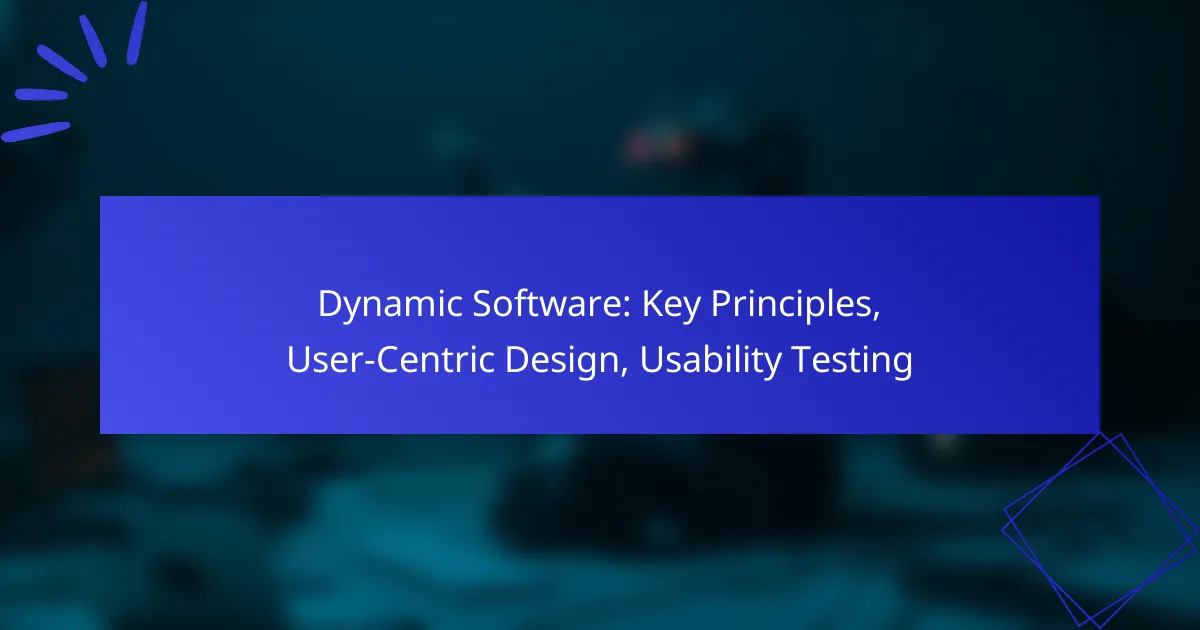Dynamic software is designed to enhance user experience by adapting in real-time to individual needs and preferences, resulting in more engaging interactions. Key principles such as flexibility, user-centric design, and continuous improvement ensure that the software remains relevant and effective in meeting evolving user demands.

How can dynamic software improve user experience?
Dynamic software enhances user experience by adapting to individual needs and preferences in real-time. This flexibility allows for more engaging interactions, leading to increased satisfaction and efficiency.
Enhanced personalization
Enhanced personalization in dynamic software tailors the user experience based on individual behaviors and preferences. For example, e-commerce platforms can recommend products based on past purchases or browsing history, significantly improving user engagement.
To implement effective personalization, consider using user data responsibly and transparently. Ensure compliance with data protection regulations, such as GDPR in Europe, to build trust and maintain user privacy.
Real-time feedback
Real-time feedback allows users to receive immediate responses to their actions, which can significantly enhance usability. For instance, when filling out a form, users can see validation messages instantly, helping them correct errors without delay.
Incorporating real-time feedback requires a robust backend system that can process user inputs quickly. Aim for response times in the low tens of milliseconds to ensure a seamless experience.
Adaptive interfaces
Adaptive interfaces adjust their layout and functionality based on user interactions and device types. This ensures that users have an optimal experience whether they are on a desktop, tablet, or smartphone.
When designing adaptive interfaces, prioritize responsive design principles. Test across various devices to ensure consistent performance and usability, aiming for a fluid experience that minimizes user frustration.

What are the key principles of dynamic software?
The key principles of dynamic software include flexibility, user-centric design, and continuous improvement. These principles ensure that software can adapt to changing user needs and technological advancements while providing a seamless experience.
Flexibility and adaptability
Flexibility and adaptability in dynamic software allow it to respond to varying user requirements and environments. This means the software can be modified or extended without significant rework, accommodating new features or changes in user behavior.
For example, a project management tool might offer customizable dashboards that users can tailor to their specific workflows. This adaptability enhances user satisfaction and engagement, as the software feels more relevant to their needs.
User-centric design
User-centric design focuses on creating software that prioritizes the needs and preferences of its users. This approach involves gathering user feedback throughout the development process to ensure the final product aligns with user expectations.
Implementing user personas and conducting usability testing can help identify pain points and areas for improvement. For instance, a mobile app should be intuitive, allowing users to navigate easily without extensive training.
Continuous improvement
Continuous improvement is the practice of regularly updating and enhancing software based on user feedback and performance metrics. This principle ensures that the software remains relevant and effective over time.
Establishing a feedback loop with users can facilitate ongoing enhancements. For example, software companies might release monthly updates that include new features or bug fixes, keeping the user experience fresh and engaging.

How does user-centric design impact dynamic software?
User-centric design significantly enhances dynamic software by prioritizing the needs and preferences of users throughout the development process. This approach leads to more intuitive interfaces and functionalities that resonate with users, ultimately improving their overall experience.
Increased user satisfaction
User-centric design directly contributes to increased user satisfaction by ensuring that software aligns with user expectations and workflows. When users find software easy to navigate and tailored to their needs, they are more likely to enjoy using it and feel positive about their experience.
To achieve this, developers should conduct user research to gather insights on preferences and pain points. Regular feedback loops during the design process can help refine features that enhance satisfaction.
Higher engagement rates
Dynamic software that employs user-centric design tends to see higher engagement rates as it captures users’ attention and encourages interaction. Features that are designed with user input often lead to more frequent use and deeper exploration of the software’s capabilities.
Incorporating elements such as personalized content, intuitive navigation, and responsive design can significantly boost engagement. For instance, software that adapts to user behavior can keep users invested and returning for more.
Improved retention
User-centric design plays a crucial role in improving user retention by creating a seamless and enjoyable experience that encourages users to return. When users feel that their needs are met and their feedback is valued, they are less likely to abandon the software for alternatives.
To enhance retention, developers should focus on ongoing user support and updates based on user feedback. Regularly introducing new features that align with user interests can also help maintain engagement and loyalty over time.

What methods are effective for usability testing?
Effective usability testing methods include A/B testing, focus groups, and remote usability testing. Each method offers unique insights into user behavior and preferences, helping to refine software design for better user experience.
A/B testing
A/B testing involves comparing two versions of a webpage or application to determine which one performs better. Users are randomly assigned to either version, and metrics such as click-through rates or task completion times are measured.
When conducting A/B tests, ensure that the sample size is large enough to yield statistically significant results. A common approach is to test one variable at a time, such as button color or layout, to isolate its impact on user behavior.
Focus groups
Focus groups gather a small group of users to discuss their experiences and opinions about a product. This qualitative method allows for in-depth feedback and can uncover insights that quantitative methods may miss.
To run an effective focus group, prepare a set of open-ended questions and encourage participants to share their thoughts freely. Be mindful of group dynamics, as dominant voices can skew the feedback. Aim for diversity in participant backgrounds to capture a range of perspectives.
Remote usability testing
Remote usability testing allows users to interact with a product from their own locations, providing convenience and access to a broader audience. This method can be conducted using screen-sharing tools or dedicated usability testing platforms.
When implementing remote testing, ensure that participants have clear instructions and a stable internet connection. Consider recording sessions for later analysis, and be prepared to ask follow-up questions to clarify user behavior. This approach is particularly useful for reaching users in different geographical areas without the constraints of travel.

What tools can facilitate usability testing?
Usability testing tools help gather user feedback on software interfaces, ensuring that designs meet user needs effectively. These tools streamline the testing process, enabling designers to identify issues and improve user experience efficiently.
UsabilityHub
UsabilityHub is a platform that offers various testing methods, including preference tests, five-second tests, and click tests. These tools allow designers to gather quick feedback on design choices, helping to refine user interfaces based on real user input.
One key feature is the ability to target specific demographics, ensuring that feedback comes from the intended user base. This can be particularly useful for tailoring designs to meet the preferences of different user segments.
Lookback
Lookback provides a comprehensive solution for live and recorded usability testing sessions. It allows researchers to observe users as they interact with a product, capturing both screen activity and user reactions in real-time.
This tool is beneficial for understanding user behavior and identifying pain points during the interaction process. Additionally, Lookback supports remote testing, making it accessible for teams working in different locations.
Optimal Workshop
Optimal Workshop offers a suite of usability testing tools focused on information architecture and user experience. It includes tools for card sorting, tree testing, and first-click testing, which help assess how users navigate and understand content.
Using Optimal Workshop, teams can visualize user pathways and make informed decisions about site structure and navigation. This tool is particularly useful for optimizing websites and applications to enhance user engagement and satisfaction.

How can businesses implement dynamic software solutions?
Businesses can implement dynamic software solutions by focusing on user-centric design principles and iterative development processes. This approach ensures that the software meets user needs and adapts to changing requirements effectively.
Define user personas
Defining user personas involves creating detailed profiles of target users based on research and data. These personas should include demographics, behaviors, goals, and pain points, allowing businesses to tailor their software solutions to specific user needs.
For example, a software aimed at small business owners might have personas representing tech-savvy entrepreneurs and those less familiar with technology. This differentiation helps in designing features that cater to both groups effectively.
Map user journeys
Mapping user journeys entails outlining the steps users take when interacting with the software. This process highlights critical touchpoints and potential obstacles, enabling businesses to enhance the overall user experience.
Consider creating a visual representation of the user journey, detailing each stage from initial awareness to post-purchase support. This can help identify areas for improvement and ensure that the software aligns with user expectations.
Iterate based on feedback
Iterating based on feedback is essential for refining dynamic software solutions. Gathering user feedback through surveys, usability tests, and direct interactions allows businesses to understand what works and what doesn’t.
Establish a regular feedback loop, where updates are made based on user insights. This could involve monthly reviews or quarterly updates, ensuring the software evolves in line with user needs and preferences.










